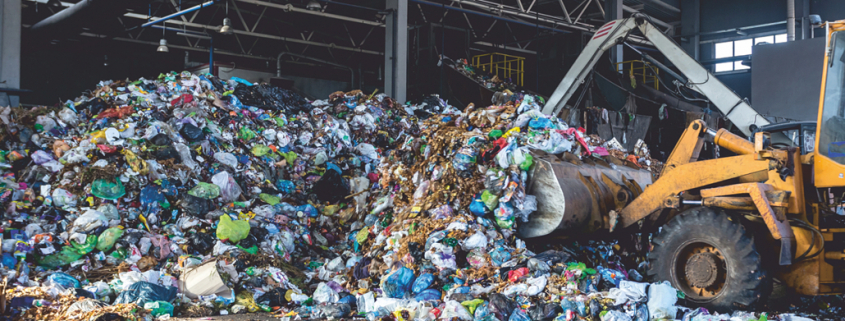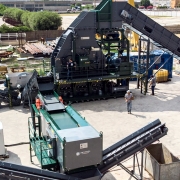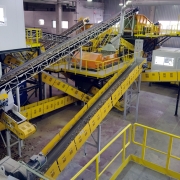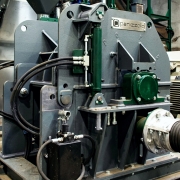Latin America and the Caribbean: Seeking the Route to Improve Waste Treatment
Latin America and the Caribbean region consist of 42 countries, including South America and the Caribbean Islands. The different territories are unique in their demand to reduce waste and start a striking recycling strategy.
In a waste management outlook for Latin America and the Caribbean in 2018, the UN Environment balanced 541,000 tons/day of municipal waste generated in Latin America and the Caribbean. Around 40 million people lacked access to waste collection, and a daily amount of 145,000 tons of waste were still disposed of in open dumpsites. It is exptected that the figures will increase, at least, by 25 percent. In other words: Recycling seems indispensable.
Recycling rate of 4,5 percent
In its “What a waste 2.0”-study, the World Bank in 2018 quantified waste disposal and treatment in Latin America. “More than half of waste is disposed of in sanitary landfills with some environmental controls, reflecting a general regional focus on sustainable disposal methods”, the study notified. 15 percent ended at controlled landfills. But the paper also had to acknowledge that open dumping accounted for about 27 percent of waste disposal. The recycling rate reached 4,5 percent, while the volumes treated by anaerobic digestion, composting and incineration were negligible. The World Bank additionally informed, that the waste collection differed between 85 percent in urban regions, mostly by a door-to-door system, while in rural communities the coverage was assured by 30 percent. The margin reached from 95 percent in cities in Uruguay and Colombia to twelve percent in Port au Prince.
The differences in collection and disposal result in varying recycling behavior. As the Rijksdienst voor Ondernemend Nederland focusing on eight countries found out, municipal waste brought to landfills ranged between “40-60” to “80-100” percent (whereupon “landfilled” can mean anything from open dumps to controlled landfills). The recycling rate strained between zero and 15 percent, and the collection rate of municipal solid waste allegedly reached 60 to 100 percent. EPR systems were mostly “under development”, in one case even on “move to mandatory”. The collection systems were predominantly financed by the citizens, but in two countries the waste tax turned out to be insufficient. Private sector suppliers in some countries were said to be specifically catering to the waste sector, while in Columbia they are established but not organized, and in Chile even well organized, but with an incomplete portfolio. And six countries specified a Circular Economy strategy.
52 percent is organic
The Inter-American Development Bank outlines that for waste management “a high participation of trade recyclers” is carrying out the collection, recovery, and resale of recovered materials. These materials were paper, cardboard, metal, plastics and industrial glass. To be more precisely, in 2018, 52 percent of the generated waste was organic, followed by undefined, but largely organic waste (15 percent), paper and cardboard (13 percent) and plastic (twelve percent). The rest consisted of glass (four percent), metal (three percent) and rubber plus leather and wood (each one percent).
In spite of ranking first in generation, organic waste is last in management, 2018 the UN Environment gave account in its outlook. And added that streams like particularly hazardous wastes, hospital waste, construction and demolition waste, food waste and electrical and electronic equipment waste “are told not to be properly treated or even not inventoried and characterized”. In Chile for example, the recycling rate of municipal waste in 2017 reached just two percent and the reuse quota of organic waste one percent. Regarding the national waste – composed of 60 percent non-hazardous industrial and 35 percent municipal waste – twelve percent of plastic packaging and five percent of tires were recovered, the circular economy oriented Netherlands Enterprise Agency wrote. And the UN Industrial Development Organization criticized that “there are no accurate figures available at present regarding investment needs in the solid waste management and recycling sector for the different countries in the LAC (Latin and Caribean) region, addressing the existing challenges will require the use of resources from both national and local governments, and private-sector participation, as well as requesting loans and technical cooperation from multilateral agencies”.
Number of sorting plants growing
Meanwhile, companies in Southern America started recycling on a bigger scale. One of them is the Brazilian Orizon Valorização de Resíduos, running five “Ecoparks” in Brazil and waste management and processing facilities for approximately 4.6 million tons of waste per year. In March 2022, the company announced the forthcoming start of the “biggest mechanical sorting plant in Latin America” (as per the Prefecture Jaboatão dos Guararapes) for the treatment of 1.5 million tons of solid waste in Pernambuco, allowing greater reuse of recyclable waste and returning it into the industrial value chain. In October 2021, Mexico City saw the start of the Azcapotzalco Transfer Station and Sorting Plant, the supposed “largest and most modern sorting plant in Latin America” (as per Pet Planet), receiving up to 1,400 tons per day and sorting paper, cardboard, multilayer packaging, PET and HDPE, plastic bags and film, aluminum cans, metalized bags, textiles, glass and other metals. And in June 2022, Buenos Aires inaugurated the allegedly “most modern recycling plant in Argentina” (as per Mundolatas.com), recovering ten tons per hour of separately collected dry materials such as pans, paper, cardboard, glass and plastic.
Plastic recycling figures unknown
One of the biggest recycling problems results from plastics. According to the newspapers, Latin America is “addicted to plastics”, and appears to be “the US‘s new plastic dumping ground” or “declares a war on plastic”. Plastic is the fourth largest component by mass of the LAC municipal waste stream, encompassing 12.4 percent on average, World Bank statistics stated. The Spanish online-Magazine Gestión de Compras says that “annually the region generates 216 million tons of solid waste, of which 12 percent is highly recyclable plastic material”. The Netherlands Enterprise Agency knew that in 2020 only 11,8 percent of plastic packaging waste from domestic (4,5 percent ) and industrial origin (17,6 percent) were valorized. Others are not so sure: “Data associated with plastics-only recycling in LAC is unknown but is likely lower than other more valuable materials like metals and paper”, the Inter-American Development Bank supposed. However, the Chilean journalist Cristian Ascencio Ojeda considers that at least most countries have progressively adopted legal measures against plastic bags or single-use plastic. But the volumes collected are low: The countries with the highest amount of residual plastic are Mexico (32,650 tons), El Salvador (4,054 tons) and Ecuador (3,665 tons). On the other hand, said the article by Gestión de Compras in 2020, the imports of plastic gave a push to the recycling sector: “The jobs that the sector is generating are already a reality … Recycling facilities are the stars at the moment.” And Jaime Camara, founder, and CEO of Mexico-based PetStar, already in 2017 stated: “Of course, the whole plastics recycling industry, specifically PET, is truly advanced and evolving.”
E-scrap potential wasted
However, e-scrap needs to attract more attention. Admittedly the recycling rates in 13 Latin American countries – according to the UN report “Regional E-Waste Monitor for Latin America” – are very low, despite most of them having at least some e-scrap-related legislation. This is relativized by a strong repair culture in these countries. But the report also shows that the e-waste generated regionally in 2019 contained 7,000 kilos of gold, 310 kilos of rare-earth metals, 591 million kilos of iron, 54 million kilos of copper, and 91 million kilos of aluminum. Of this potential, only three percent are collected and treated by environmentally sound methods, while 97 percent are improperly treated. The lost value of roughly 1.7 billion US-Dollar of secondary raw materials was commented on by a website titled “How Latin America wastes billions of Dollars worth of valuable metals”. But according to the market research & consulting firm 6W Research, the expanding market and technological advancements are increasingly encouraging the recycling of metal scrap due to its value.
The recovery of paper has some tradition in Latin America. A research paper written in 2003 shows, amongst others, a rate of 38 percent for paper and 73 percent for cardboard in Brazil. Venezuela reached 25 percent for both materials, while Argentina recovered 35 percent of its paper. Chile even realized a paper and cardboard recycling quota of around 50 percent. In an interview in 2019, Yury Bulgakov, Vipa Group regional director of North Europe and South America, spoke of 400 pulp and paper mills located across Latin America. Business Market Insight in 2022 expected growth of the South & Central America recycled paper market from 3,353.5 million US-Dollar in 2021 to 4,583.0 million US-Dollar by 2028.
Tire recycling progressing
Concerning tire recycling, Reciclanip started in 1999 as National Program for the Collection and Disposal of Waste Tires implemented by Anip (National Association of the Tire Industry), who represents manufacturers of new tires in Brazil. From the start of operations until the end of 2020, with more than 1,035 collection points spread across the country, more than 5.23 million tons of waste tires were collected and properly disposed of, equivalent to 1.1 billion tires outing. The national industry has already invested 1.6 billion Brazilian Real in this operation. According to the project, Reciclanip is considered one of the biggest initiatives of the Brazilian industry in the area of post-consumer responsibility and is comparable to the largest recycling programs developed in the country, in particular, that of aluminum cans and pesticide packaging. Additionally in 2016, the mining company Carbones del Correjon Ltd. announced the opening of a new tire recycling plant in Colombia. The plant, located in Albania in the province of La Guajira, accesses a recycling capacity of 2,360 tires per year and a production potential of 2,300 tons of steel and nearly 5,000 tons of crumb rubber for roadworks. Processing large tires weighing almost 3.5 tons, the facility is said to be the first of its kind in the entire Latin American region.
WtE-sector proliferating
Regarding power and heat recovery, Latin America showed attempts. Meanwhile, a handful of biogas plants have been installed and since 1992, Votorantim Cimentos deploys the first cement plant co-processing technique of industrial waste. Moreover, the thermal substitution rate has achieved 15 percent, the Italian company P&W Engineering and Consulting announced a feasibility study and preliminary designs for a plant in Buenos Aires, and the Barueri project was planned as “first WTE project” with the first “mass burn WtE contract” in Brazil. (More details can be found in Global Recycling 3/2021). But according to a research report of the Netherlands Enterprise Agency in February 2021, “to date, there is no such plant in Argentina (and not even in South America, for that matter)”. On the other hand, market research company Triton suggests “that the waste-to-energy market in Latin America would proliferate with 6.24 percent of CAGR in the forecasting period of 2019 to 2027”. And according to Triton and Research & Markets, several companies – amongst some others Waste Management Inc., Hitachi Zosen Corporation, Veolia Environnement S.A., Babcock & Wilcox Enterprises Inc. and China Everbright International – are “preeminent companies in the waste-to-energy market”.
Recycling has a great potential
“Latin America has barely implemented eco-efficiency of a circular economy for lack of regulations encouraging such transition”, the Latin American and Caribbean Economic System (SELA) – an intergovernmental regional organization of 25 Latin American and Caribbean countries – had to confess in November 2021. “Waste management and recycling have a great potential of job creation and economic development for Latin America and the Caribbean”, the association stated and regarded circular economy as the driving force for Latin American and Caribbean recovery, able to launch direct and indirect effects of waste management on annual production for Chile, Colombia and Mexico ranging from 0.53 percent to 1.1 percent of their gross domestic product. Chile, for example, is aiming at the reduction of household waste going to landfills from currently 96 to 10 percent and features the ambition “to go from one percent recovery to 66 percent by the year 2040 by aiming for citizens to generate less organic waste, achieve a greater separation at the source, and by providing infrastructure, equipment and logistics systems”, Netherlands Enterprise Agency anticipates. The independent policy institute Chatham House recognizes waste management and recycling among the three industrial areas that are a priority for the circular economy.
The policy agreed upon: In February 2021, the Ministers of Environment of Latin America and the Caribbean met, signed a Decision on Sustainable Consumption and Production and Circular Economy, formally launched the Circular Economy Coalition for Latin America and the Caribbean and thus inaugurated more than 80 public policy circular economy initiatives and the increasing number of national circular economy roadmaps and strategies that were in development, the Circular Economy Coalition stated.
Investment is necessary
At a rough estimate, better waste management could create up to 4.8 million jobs across the region by 2030, the UN’s Economic Development Division of the Economic Commission for Latin America and the Caribbean reported. By 2050, it would be able to generate 7.7 million new jobs and save up to 621 billion US-Dollar annually, an UN Environment Programme report states. Chile, for example, has set a target of creating more than 180,000 formal jobs in the circular economy by 2040, according to the Oxford Business Group. So there can be no doubt whether an investment is necessary – for the policy and the economy. The Chatham House additionally advises “to attract both domestic and foreign investments beyond the waste management sector to make the transition to a circular economy possible”. However, at the moment, the financing situation for the circular economy in the region “is limited mainly to the provision of international development finance”, and investment in science and technology is characterized as “still comparatively low”.
Integration of the informal sector?
A secondary problem is the integration of waste pickers into an organized waste management system. The informal sector consists of around four million people, according to the Regional Initiative for Inclusive Recycling. The sector contributes approximately 25 to 50 percent of all municipal waste collection in the region, an article in the Forbes Magazin informed. And the paper gave the hint of “an enormous opportunity for investment to create a safer environment for these critical participants in the recycling value chain while”. A path has to be found that serves the interests of policy, investors and waste pickers. The consulting and advisory organization BioEnergy Consult proposes that “in order to improve the working conditions of waste pickers, and in order to increase recycling rates, we don’t need high technology”. Another possibility was offered by Chatham House, that in September 2020 assessed Industry 4.0 as a “key enabler of the circular economy” and recommended new business models to be profitable. Or as the Inter-American Development Bank wrote: “The principles of the circular economy … and the involvement of the industrial sector through extended producer responsibility plans are all gaining strength in the region”. The truth might lie in the middle: In 2011, the German Association for International Cooperation published a study titled “Integrating the informal sector into solid waste management”. The authors underlined that partnerships among the private sector, between formal and informal actors, would become more and more important. So, “support activities should not be limited to improve the social conditions of informal waste workers, but be aimed at establishing business activities that are economically viable over the longer term”.
(Published in GLOBAL RECYCLING Magazine 1/2023, Page 22, Photo: hiv360 / stock.adobe.com)










